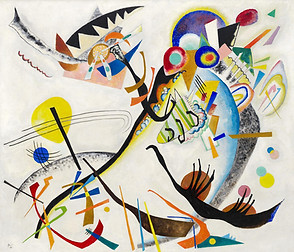PLAY with PAINT - Abstract Watercolor
MODULE: Painting | GRADE LEVELS: 1 - 6 | DURATION: 1 Hour
PROJECT 19 | 11.29.21
PROJECT GUIDE PDF - Click to Download
ARTIST VIDEO
Video Editing by Jorge Davies, Graphics by Melissa Sabol
PROJECT VIDEO
OVERVIEW
Learn to create beautiful, abstract shapes using these eight different watercolor techniques. Combine different ones to make your own unique designs!
WHY IT'S IMPORTANT
-
Challenges us to make something unknown. Something that doesn’t look like anything we’ve ever seen before.
-
Inspires freedom to play with materials and experiment with different techniques.
-
Shows us how small changes in the use of materials can create unexpected outcomes.
-
Requires us to let go of control - the materials have a mind of their own.
-
Teaches patience - sometimes you have to wait and see what the materials will do.
MATERIALS
-
Watercolor Paint
-
Round Paintbrush
-
Flat Paintbrush
-
Thick Paper
-
Water Jar
-
Paper Towels
-
Rag Towel
INSTRUCTIONS
1. Prepare Paper:
-
Fold your paper into 8 sections: fold your paper in half hamburger-style 3 times.
-
Open Paper: Open your paper up and you should end up with 8 rectangles.

2. Watercolor Techniques
1.
Flat Wash - Smooth Application
Use flat brush. Pick one color and mix with a little water. Sweep back and forth evenly to coat one rectangle with paint.

2.
Graded Wash or Ombré - Fades Dark to Light
Pick one color. Use gentle, sweeping movements to add the color to one third of the rectangle. Dab off paint from your brush on towel. Dip in water. Paint the next third in the lighter tone. Dab the paintbrush on towel again. Add more water and paint the lightest tone last.

3.
Color Blend - Add 3 Colors Together
Pick 3 colors. Apply flat wash of one color to a third of the rectangle. Pick a 2nd color and add it to the middle. Blend where the areas touch. Apply 3rd color to the last part of the rectangle. Blend again where the areas touch.

4.
Dry Brush - Scratchy Texture
Wipe brush on towel, grab a little paint, apply on paper. May need a little more water. Make sure to dab on towel so it’s not too wet. Brush gently.

5.
Wet on Wet - Color Flow
Paint the rectangle with water. Add one color on the top and another on the bottom. You’ll start to see color bleeding. You can even pick up the paper and move it.

6.
Blot - Paint Removal
Paint a flat wash of color. Take a piece of towel. Dab some color off and let it dry.

7.
Lines - Thin and Thick
Paint a flat wash in lighter color and let it dry. Come back later. Using the round brush and darker paint, create a thick line by applying more pressure and a thinner line by painting more lightly.

8.
Blooms - Spreading Splotches
Do a flat wash in a lighter color. While it’s still wet, make dots by adding a dark color. Add drips of water and watch the color "bloom".

ASSIGNMENT
Make a Painting:
Combine the techniques that you learned in the last step to create a beautiful painting! You can have fun making a grouping of shapes that don’t look like anything or you can create any scene you want to with the watercolors!
ARTISTS TO KNOW

Wassily Kandinsky
Wassily Kandinsky was a Russian painter and art theorist. He was born in 1866. He is one of the pioneers of abstract art. He embraced all types of artistic styles like Art Nouveau (organic forms), Fauvism (shocking colors), Surrealism (mystery) and Bauhaus (constructivism) before moving towards abstractionism. His object-free paintings have an ambiguity of the form rendered in a variety of colors as well as a resistance against conventional aesthetic values of the art world during his time.
Watercolor No. 14, 1913
Website >>

Georgia O’Keeffe
Georgia O’Keeffe used her paintings as a tool to represent the world she saw around her. She had a signature style, often painting flowers so close up they became abstract images, often being defined by their organic shapes and depth of color. O’Keeffe fell in love with the sweeping desert landscapes of New Mexico, and spent most of her time there, painting representations of the surrounding nature. O’Keeffe, with her serene painting style, was a trailblazer for many other women artists to come.
A Sky Above Clouds IV, 1965
Website >>

Lourdes Sanchez
Lourdes Sanchez is a Cuban-born New York artist whose primary mediums are watercolor and ink, which she uses to explore compositions that are equal parts geometric and organic. Some of her paintings reflect the light of New York at dusk, while others show the intense humidity, lively insects, birds and cantina music that infused the Yucatan evenings where they were created.
Field 2, 2016
VOCABULARY
Watercolor: A type of paint that is thinned with water, creating a transparent color. It can also refer to a type of painting that is made with watercolor paints.
Watercolor Paper: Lightly textured paper that absorbs paint and water.
Wash: A mixture of water and pigment, usually with more water than color, so as to create a transparent layer of paint.
Graded Wash: A wash that goes from dark to light, either by dragging a pigmented brush slowly across paper, as the pigment runs out of the brush, or by creating bands of color that are a lighter tone than the band painted before.
Blot: To remove color and water with a towel or rag.
Transparent: Something is transparent when you can see through it to something underneath or behind the object. A window is transparent.